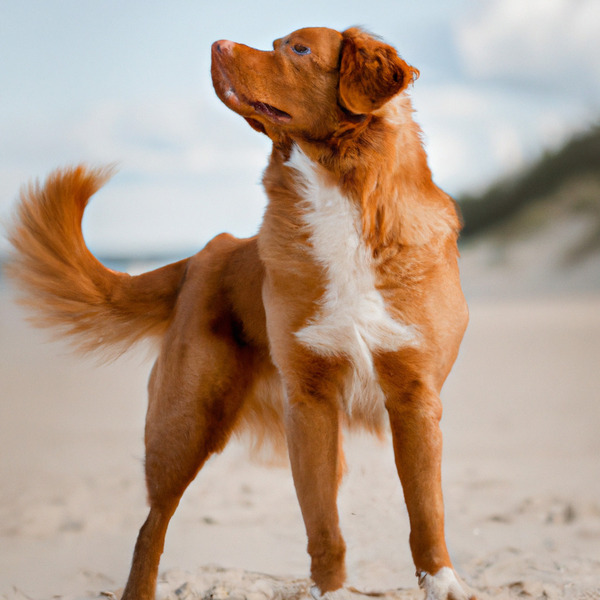Nova Scotia Duck Tolling Retriever vs. Mastapeake: Breed Differences and Similarities
Hypoallergenic
Are Nova Scotia Duck Tolling Retrievers or Mastapeakes hypoallergenic, or neither?
Unfortunately, neither Nova Scotia Duck Tolling Retriever nor Mastapeake are hypoallergenic, which may not make them the best choice for dog lovers who suffer from pet allergies.
Temperament
What are the personalities of Nova Scotia Duck Tolling Retriever and Mastapeake dogs?
Affectionate
Courageous
Gentle
Responsive
Alert
Energetic
Playful
Happy
Protective
Alert
Courageous
Intelligent
Affectionate
Dominant
Loyal
Cheerful
Quiet
Shedding Level
Do Nova Scotia Duck Tolling Retrievers shed more than Mastapeakes, or which breed sheds more, Nova Scotia Duck Tolling Retrievers or Mastapeakes?
Nova Scotia Duck Tolling Retriever or Mastapeake dogs are not heavy shedders, but they will lose a significant amount of hair each year. To decrease the amount of shedding, you can regularly brush your Nova Scotia Duck Tolling Retriever or Mastapeake. This will remove loose hair and keep their coat growing in the same direction.
Ancestry
What are the origins of Nova Scotia Duck Tolling Retriever and Mastapeake breeds?
Cocker Spaniels, farm Collies, Irish Setters
Mastiff and Chesapeake Bay Retriever
Date of Birth
When were Nova Scotia Duck Tolling Retriever and Mastapeake breeds first developed?
19th Century
Unknown
Eye Color Possibilites
What are the eye colors of Nova Scotia Duck Tolling Retriever and Mastapeake dogs?
Hazel
Brown
Amber
Brown
Amber
Nose Color Possibilites
What are the natural nose colors of Nova Scotia Duck Tolling Retriever and Mastapeake?
Black
Brown
Black
Brown
Coat Color Possibilites
What are the natural colors of the coat for Nova Scotia Duck Tolling Retriever and Mastapeake breeds?
Red
Cream
Brindle
Sable
Fawn
Red
Brown
Coat Length
What is the typical coat length for Nova Scotia Duck Tolling Retriever and Mastapeake breeds?
Nova Scotia Duck Tolling Retrievers have medium-length coats.
Mastapeakes have coats that can be either short or medium in length.
Coat Density
What is the density of the coat of Nova Scotia Duck Tolling Retriever and Mastapeake?
Coat Texture
What is the hair texture of Nova Scotia Duck Tolling Retriever and Mastapeake?
Straight
Litter Size
What is the usual litter size for Nova Scotia Duck Tolling Retriever and Mastapeake?
A Nova Scotia Duck Tolling Retriever can have a litter of 12-14 puppies on average. However, it's worth noting that the size of the litters can vary greatly. Factors that can influence litter size include the health of the mother, breeding history, and genetics.
A Mastapeake can have a litter of 7-9 puppies on average. However, it's worth noting that the size of the litters can vary greatly. Factors that can influence litter size include the health of the mother, breeding history, and genetics.
Adaptability
Nova Scotia Duck Tolling Retrievers are highly adaptable and versatile, making them excellent companions for families and individuals of all lifestyles.
Mastapeakes are known for their adaptability and can adjust well to different environments and lifestyle changes.
Health Issues
Between Nova Scotia Duck Tolling Retriever and Mastapeake, which breed is more prone to health problems?
The Nova Scotia Duck Tolling Retriever and Mastapeake breeds are commonly healthy with low vet costs, regular check-ups may not be as necessary but it's important to keep an eye on their health and have them checked by a veterinarian when needed.
Major Concerns
What are the major health concerns for Nova Scotia Duck Tolling Retriever and Mastapeake breeds?
Hip Dysplasia
Progressive Retinal Atrophy (PRA)
Pulmonic Stenosis
Canine Hip Dysplasia
Gastric Dilation Volvulus (GDV) or Bloat
Minor Concerns
What minor health issues should be kept in mind when owning Nova Scotia Duck Tolling Retriever and Mastapeake?
Collie Eye Anomaly (CEA)
Entropion
Ectropion
Elbow Dysplasia
Osteosarcoma
Cataracts
Retinal Dysplasia
Exposure Keratopathy Syndrome
Progressive Retinal Atrophy (PRA)
Occasional Tests
What occasional tests are recommended for Nova Scotia Duck Tolling Retriever and Mastapeake breeds?
OFA
CERF
Hearing Tests
Eye Examination
Biopsy
Electrocardiogram
Radiographs
Thyroid Testing
Social Needs
Nova Scotia Duck Tolling Retriever vs Mastapeake social needs comparison
Nova Scotia Duck Tolling Retriever has above average social needs and thrives with interaction with humans and other dogs.
Mastapeake has average social needs and is less independent than other breeds.
Sleeping Need
Which of the two sleeps the most/least: Nova Scotia Duck Tolling Retriever or Mastapeake?
Nova Scotia Duck Tolling Retrievers are active and require sufficient sleep to stay healthy.
Mastapeakes have moderate energy levels and typical sleep patterns of 12-14 hours per day.
Mouthiness
Mouthiness Comparison: Nova Scotia Duck Tolling Retriever vs Mastapeake?
Roaming urge
Nova Scotia Duck Tolling Retriever vs Labrador: Running away tendency?
Prey Drive
Nova Scotia Duck Tolling Retriever or Mastapeake - which breed has a higher level of prey drive?
Past times
What are some enjoyable activities and ways to keep Nova Scotia Duck Tolling Retriever and Mastapeake entertained?
Fetch, Bike ride, Dog Parks, Walk, Run
Fetch, Running
Activity Level
Which breed has higher energy, Nova Scotia Duck Tolling Retrievers or Mastapeakes?
Nova Scotia Duck Tolling Retrievers are high-energy dogs. They need mental as well as physical exercise. These dogs require a lot of your involvement and without it they can, and will, become problematic dogs.
Mastapeakes are medium-energy dogs and typically enjoy socializing and playing casual or even sustained games of chase with other dogs. They may also have occasional periods of barking or racing around the house.
Tolerance of being left alone
Walks per Week
How many miles should Nova Scotia Duck Tolling Retriever or Mastapeake walk each week?
There's really no limit to how far you walk your dog as long as they're comfortable. For Nova Scotia Duck Tolling Retriever, it's at least 10 miles / week. Just remember to build distance and stamina gradually over time.
There's really no limit to how far you walk your dog as long as they're comfortable. For Mastapeake, it's at least 9 miles / week. Just remember to build distance and stamina gradually over time.
Activity per Day
Do Nova Scotia Duck Tolling Retrievers or Mastapeakes require more exercise?
Both Nova Scotia Duck Tolling Retriever and Mastapeake typically require a minimum of 60 minutes of exercise each day. The exercise can be spread throughout the day and may involve high-energy activities like walking, running, and playing.
Grooming
Which breed is easier to maintain in terms of grooming, Nova Scotia Duck Tolling Retrievers or Mastapeakes?
Nova Scotia Duck Tolling Retriever and Mastapeake are breeds of dogs that are known for their low grooming needs.
Brushing Frequency
What is the recommended brushing frequency for Nova Scotia Duck Tolling Retriever and Mastapeake dogs?
Nova Scotia Duck Tolling Retriever and Mastapeake should be brushed at least once a week. Of course, you can give them more frequent brushes if you find that they are still shedding a lot.
Brushing Tools
What brushing tools are used for Nova Scotia Duck Tolling Retrievers and Mastapeakes?
Pin Brush
Dematter
Comb
Nail Clipper
Pin Brush
Deshedder
Nail Clipper
Cups
How much food should be given to Nova Scotia Duck Tolling Retriever or Mastapeake in cups?
For an average 44-51 pound (20 - 23 kg) Nova Scotia Duck Tolling Retriever feed 2.3 cups daily. But, keep in mind, the amount you feed is going to be dependent on the quality of the food you are feeding.
For an average 105-160 pound (48 - 73 kg) Mastapeake feed 3.5 cups daily. But, keep in mind, the amount you feed is going to be dependent on the quality of the food you are feeding.
Daily Cost
Which breed has a higher daily cost, Nova Scotia Duck Tolling Retriever or Mastapeake?
The average cost of a Nova Scotia Duck Tolling Retriever is somewhere $1.70 - $2.00 per day.
The average cost of a Mastapeake is somewhere $3.90 - $4.20 per day.
Monthly Cost
Which breed has a higher monthly cost, Nova Scotia Duck Tolling Retriever or Mastapeake?
The average per month expenses of a Nova Scotia Duck Tolling Retriever is between $48 - $63. This makes an average of $576 - $756 per year. It will be on the higher side when the dog is still small because it will need more frequent visits to the vet, shots.
The average per month expenses of a Mastapeake is between $112 - $126. This makes an average of $1344 - $1512 per year. It will be on the higher side when the dog is still small because it will need more frequent visits to the vet, shots.
Sensitivity Level
How do Nova Scotia Duck Tolling Retriever and Mastapeake compare in sensitivity?
Nova Scotia Duck Tolling Retriever and Mastapeake dogs have average emotions and are adaptable to different situations, not requiring extra care like sensitive breeds do.
Apartment Friendly
Which breed is more apartment-friendly: Nova Scotia Duck Tolling Retriever or Mastapeake?
Nova Scotia Duck Tolling Retrievers are good apartment dogs as long as they get enough exercise and stimulation outside of the apartment.
Mastapeakes can do well in apartments with enough exercise and time outside, but a small yard would be ideal.
Child Friendly
Do Nova Scotia Duck Tolling Retrievers or Mastapeakes have a friendlier temperament towards children?
The typical characteristics of Nova Scotia Duck Tolling Retriever and Mastapeake indicate that this breed of dog is an ideal companion for kids and makes them family pets. Their gentle and protective nature and calm mentality make them gel along quickly with the younger humans.
Senior-friendly
Which dog is more suitable as a pet for the elderly - Nova Scotia Duck Tolling Retriever or Mastapeake?
Cat Friendly
Do Nova Scotia Duck Tolling Retriever or Mastapeake breeds have a better compatibility with cats?
Nova Scotia Duck Tolling Retrievers are average in their friendliness toward cats and tend to do well with them, especially if raised together.
Mastapeakes are good with cats, but early training is needed to prevent chasing behavior.
Dog Friendly
Which breed is more sociable with other dogs: Nova Scotia Duck Tolling Retriever or Mastapeake?
Nova Scotia Duck Tolling Retrievers are generally very friendly towards other dogs, with a happy and affectionate temperament.
Mastapeakes are average in their friendliness towards other dogs, and socialization can help.
Pet friendly
How do Nova Scotia Duck Tolling Retriever or Mastapeake dogs interact with other pets?
Stranger Friendly
Which breed is more friendly with strangers: Nova Scotia Duck Tolling Retriever or Mastapeake?
Nova Scotia Duck Tolling Retrievers are quick to announce strangers and can be standoffish or suspicious.
Mastapeakes are averagely friendly around strangers but benefit from early socialisation.
Playfulness
Which breed is more playful between Nova Scotia Duck Tolling Retriever and Mastapeake?
Nova Scotia Duck Tolling Retrievers are very playful, so adopting an older one might be a better option for a more relaxed experience.
Mastapeakes have an average level of playfulness, enjoying playtime like most dogs but not excessively so.
Trainability
How do the trainability levels of Nova Scotia Duck Tolling Retrievers and Mastapeakes compare?
Nova Scotia Duck Tolling Retrievers are popular for their ease of training and quick learning ability.
Mastapeakes are usually easy to train but require consistency to fully obey commands.
Compare Nova Scotia Duck Tolling Retriever with other breeds

Mastapeake
Nova Scotia Duck Tolling Retriever vs Mastapeake

Belgian Tervuren
Nova Scotia Duck Tolling Retriever vs Belgian Tervuren

Hanover Hound
Nova Scotia Duck Tolling Retriever vs Hanover Hound

Plott Hound
Nova Scotia Duck Tolling Retriever vs Plott Hound

Cursset
Nova Scotia Duck Tolling Retriever vs Cursset

Italian Greyhound
Nova Scotia Duck Tolling Retriever vs Italian Greyhound

Miniature Ausseippet
Nova Scotia Duck Tolling Retriever vs Miniature Ausseippet

Yorkshire Terrier
Nova Scotia Duck Tolling Retriever vs Yorkshire Terrier

Jack Russell Terrier
Nova Scotia Duck Tolling Retriever vs Jack Russell Terrier

Schnorgi
Nova Scotia Duck Tolling Retriever vs Schnorgi

Engatzu Spaniel
Nova Scotia Duck Tolling Retriever vs Engatzu Spaniel

Cane Corxer
Nova Scotia Duck Tolling Retriever vs Cane Corxer
